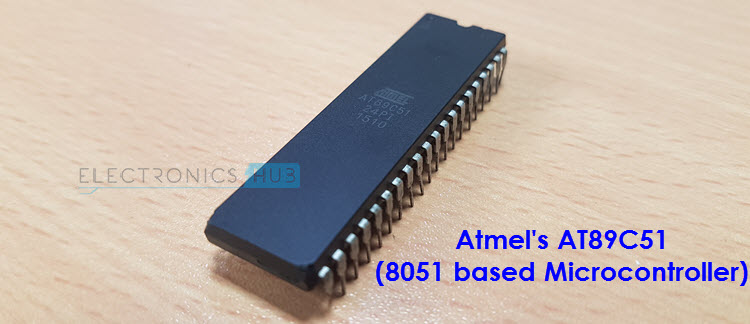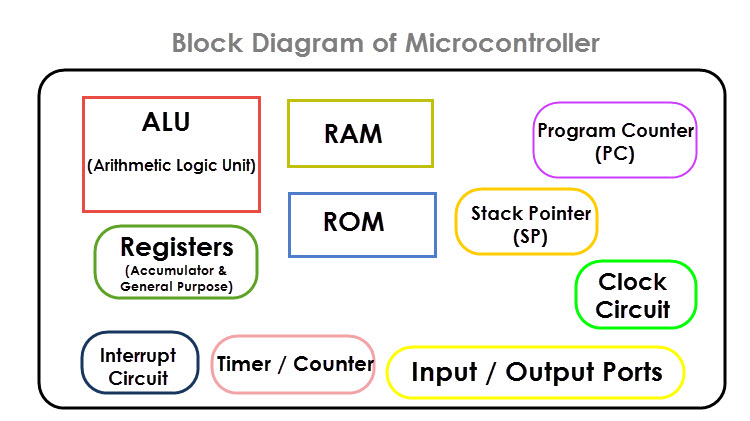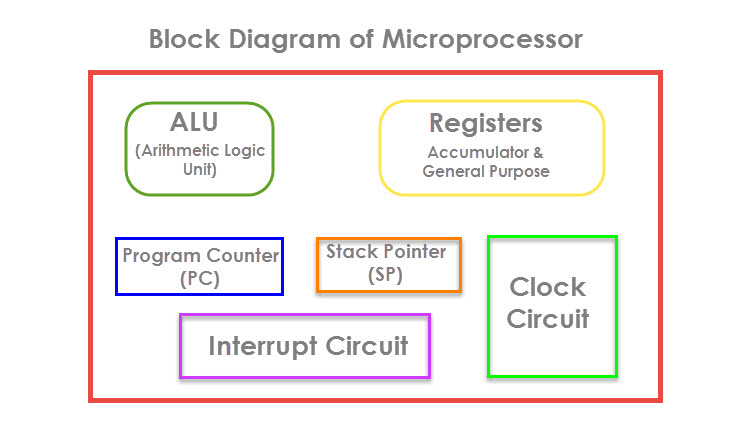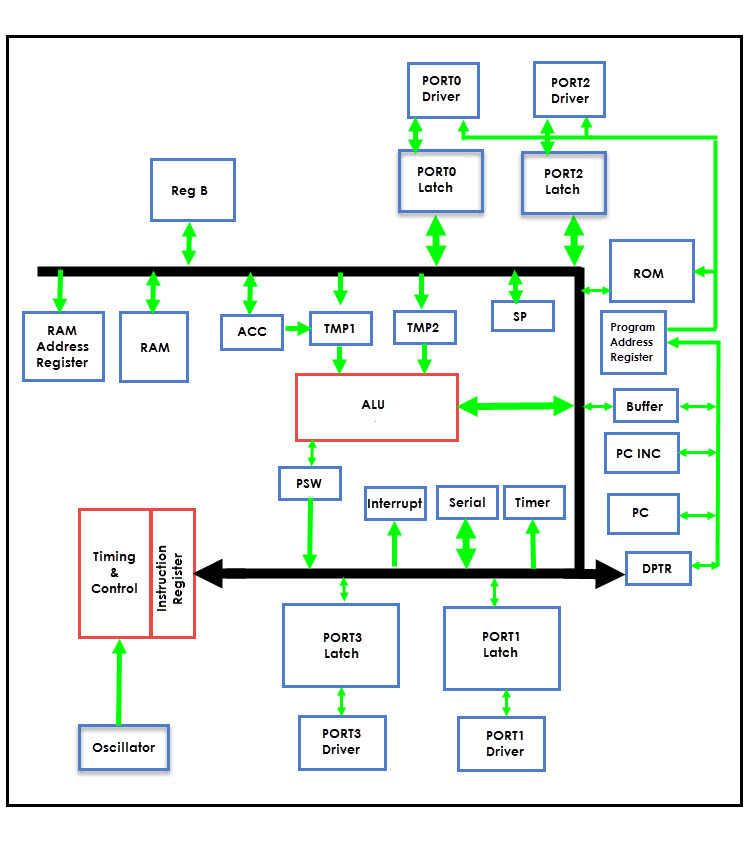This article is about the 8051 Microcontroller Introduction and some of its basic features. The 8051 Microcontroller is one of the most popular and most commonly used microcontrollers in various fields like embedded systems, consumer electronics, automobiles, etc.
Outline
Toggle8051 Microcontroller Basics
Technically called as Intel MCS-51 Architecture, the 8051 microcontroller series was developed by Intel in the year 1980 and were very popular in the 80’s (still are popular).
8051 Microcontroller has many features like Serial Communication, Timers, Interrupts, etc. and hence many students and beginners start their work on the concept of Microcontrollers with 8051 Microcontroller (although this trend seems to be changed with the introduction of Arduino).
Even though 8051 Microcontroller might seem a little bit out of fashion, we feel that it is one of the best platforms to get started with Microcontrollers, Embedded Systems and Programming (both C and Assembly).

So, in this post, you’ll be given an introduction to 8051 microcontroller and some of the basics of 8051 Microcontroller.
But before going in to the Introduction and Basics of 8051 Microcontroller, we need to a little bit about what a Microcontroller is and Difference between Microprocessor and Microcontroller.
The Differences between Microprocessor and Microcontroller are tabulated in this post.
What is a Microcontroller?
A Microcontroller is a VLSI IC that contains a CPU (Processor) along with some other peripherals like Memory (RAM and ROM), I/O Ports, Timers/Counters, Communication Interface, ADC, etc.

On the contrary, a Microprocessor (which was developed before Microcontroller) is just a Processor (CPU) and doesn’t have the above mentioned peripherals. In order to make it work or build a system around it, we need to interface the peripherals separately.

Until the development of Microcontrollers, almost all process and control tasks were implemented using Microprocessors. As Microprocessor need the additional peripherals to work as a system, the overall cost of the control system was high.
But with the development of Microcontroller, the situation has changed completely including the world of Embedded Systems.
8051 Microcontroller Introduction and History
The 8051 Microcontroller Introduction gives a brief overview about the 8051 Microcontroller and its history. Intel’s 8051 Microcontroller (Intel MSC-51 Architecture) was a successor to 8048 Microcontroller (Intel MSC-48 Architecture).
Originally, 8051 Microcontrollers were developed using N-MOS Technology but the use of battery powered devices and their low power consumption lead to usage of CMOS Technology (which is famous for its low power consumption).
Even though Intel developed 8051 Microcontrollers (which is discontinued in 2007), more than 20 semiconductor manufacturers are still producing 8051 compatible microcontrollers i.e. processors based on MSC-51 Architecture.
Some of the 8051 Microcontrollers produced by different manufacturers are: Atmel (AT89C51, AT89S51), Phillips (S87C654), STC Micro (STC89C52), Infineon (SAB-C515, XC800), Siemens (SAB-C501), Silicon Labs (C8051), NXP (NXP700, NXP900), etc.
Majority of the modern 8051 Microcontrollers are Silicon IP Cores (Intellectual Property Cores) but discrete 8051 Microcontroller IC’s are also available. Because of their low power consumption, smaller size and simple architecture, 8051 IP Cores are used in FPGAs (Field Programmable Gate Array) and SoCs (System on Chip) instead of Advanced ARM Architecture based MCUs.
Applications of 8051 Microcontroller
Even with the development of many advanced and superior Microcontrollers, 8051 Microcontroller is still being used in many embedded system and applications.
Some of the applications of 8051 Microcontroller are mentioned below:
- Consumer Appliances (TV Tuners, Remote controls, Computers, Sewing Machines, etc.)
- Home Applications (TVs, VCR, Video Games, Camcorder, Music Instruments, Home Security Systems, Garage Door Openers, etc.)
- Communication Systems (Mobile Phones, Intercoms, Answering Machines, Paging Devices, etc.)
- Office (Fax Machines, Printers, Copiers, Laser Printers, etc.)
- Automobiles (Air Bags, ABS, Engine Control, Transmission Control, Temperature Control, Keyless Entry, etc)
- Aeronautical and Space
- Medical Equipment
- Defense Systems
- Robotics
- Industrial Process and Flow Control
- Radio and Networking Equipment
- Remote Sensing
8051 Microcontroller Basics
8051 is an 8 – bit Microcontroller i.e. the data bus of the 8051 Microcontroller (both internal and external) is 8 – bit wide. It is a CISC based Microcontroller with Harvard Architecture (separate program and data memory).
Since the basic layout of a microcontroller includes a CPU, ROM, RAM, etc. the 8051 microcontroller also has a similar layout. The following image shows a brief layout of a typical 8051 Microcontroller.

8051 Microcontroller Features
- 8 – Bit ALU: ALU or Arithmetic Logic Unit is the heart of a microcontroller. It performs arithmetic and bitwise operation on binary numbers. The ALU in 8051 is an 8 – Bit ALU i.e. it can perform operations on 8 – bit data.
- 8 – Bit Accumulator:The Accumulator is an important register associated with the ALU. The accumulator in 8051 is an 8 – bit register.
- RAM: 8051 Microcontroller has 128 Bytes of RAM which includes SFRs and Input / Output Port Registers.
- ROM: 8051 has 4 KB of on-chip ROM (Program Memory).
- I/O Ports: 8051 has four 8 – bit Input / Output Ports which are bit addressable and bidirectional.
- Timers / Counters: 8051 has two 16 – bit Timers / Counters.
- Serial Port: 8051 supports full duplex UART Communication.
- External Memory: 8051Microcontroller can access two 16 – bit address line at once: one each for RAM and ROM. The total external memory that an 8051 Microcontroller can access for RAM and ROM is 64KB (216 for each type).
- Additional Features: Interrupts, on-chip oscillator, Boolean Processor, Power Down Mode, etc.
NOTE: Some of the features like size of RAM and ROM, number of Timers, etc. are not generic. They vary by manufacturer.
8051 Microcontroller Packaging
8051 Microcontroller is available in a variety of IC Packaging Types. The most popular and commonly used 8051 Microcontroller Packaging is Dual in-line or DIP. It is often available as a 40 – pin PDIP or Plastic DIP IC.
The other common packaging type is 44 – Lead PLCC (Plastic Leaded Chip Carrier). It is a kind of surface mount package.
Another surface mount packaging for 8051 microcontroller is 44 – Lead TQFP (Thin Quad Flat Package).
This article gave an introduction to 8051 Microcontroller and some its basic features. In the next article, we will see the Pinout Diagram, Pin Description and Architecture of 8051 Microcontroller.


11 Responses
Very knowledgeable
Ty so much for this kind of easy notes. It’s really best and simple to understand.
Thanks much buddy
Very good information with easy language.Thanks
Hi,
quite sentimental article: I wrote Masters thesis on Motorola 6800 microcontroller simulation on ICL 1900 mainframe, but yet in 1979, year before 8051 was born … Nothing has changed apart the world.
it is very useful for easy understanding of the basics
Its awesome to learn and understand in a easy way
thank you
thank you very much
this information is very helpful for me thank u so much
Very nice and short presentation. Very helpful for the beginners, Thanks
Very well written series. Much easier to read than the original product manual.
I could have made very good use of this series when I started using the 8051 in 1990.
Since then I have designed and built several machine controllers.
My background is Avionics technician (35years) & Industrial / University Electronics Tech.
I have been the compiler / subject author of a complete aircraft maintenance manual.
Now retired, I’m still messing with electronics.
Thank you,u are best one and only to helpful me